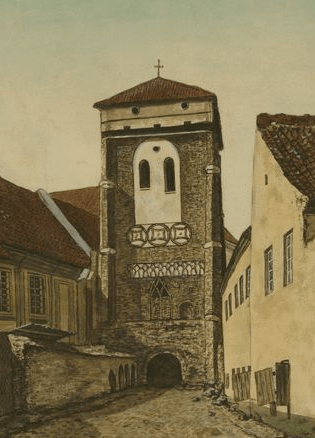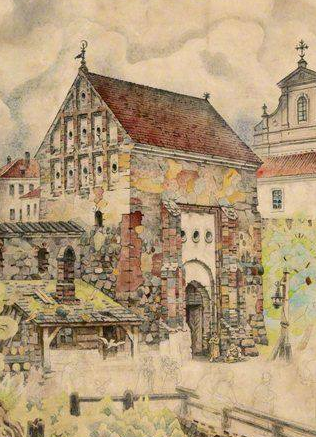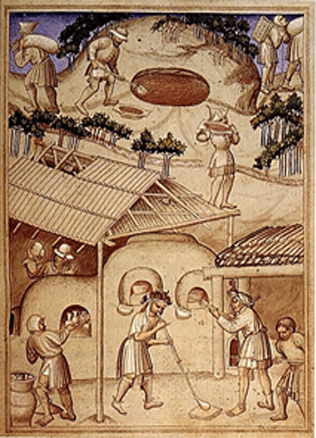The Common Work, or How the Habit of Communal Solidarity Turned into Slavery
Many phenomena of public and national life in the Grand Duchy of Lithuania bore names that, even in Lithuanian, had Slavic roots: valsčius (rural district), dvaras (manor), valakas (area measurement unit; Polish: wloka), bažnyčia (church), turgus (market) and so on. Now we consider these words Lithuanian, which is not surprising because they seeped into the Lithuanian language at the time when Ruthenian and Polish were the two dominating languages among the political groups of the state. It might seem strange that today’s Lithuanians never use and even do not understand some of the old Lithuanian words that feature the documents, in Slavic languages, from between the 15th and the late 18th century: dėkla, mėsliava (mezleva), veldamas, dailidė, jauja. Some of them have penetrated into Slavic languages so deeply that are now considered local words. Talka (Russian: толка; Polish: tłoka) is one of such words. Historically, it was used to name a rural custom when local people would gather to help someone from their village to get in the harvest. In return, the family would arrange a party with plenty of eating, drinking, dancing and playing games. Although the very term talka has always been used in the Lithuanian language, up to present days, its meaning has been changing over the course of history.
Endless toil in someone else’s fields
The 1557 regulations concerning the duties of the people who belonged to the estates of the Grand Duke of Lithuania defined their duties in the following manner: “Every wolok of a peasant who is obliged to work for the estate must correspond to two working days [in the benefit of an estate] each week and to talka every season with the required equipment. Therefore, those people should be exempted from working during the week before Christmas and during the Week of the Great Fast, and during the week before Easter. In the event their work is not required, those people should be given additional taxable land, and they will be obliged to pay 30 mites for each plot of the land and 12 [mites] for each talka or 12 mites for talkas. For gvolts (urgent work) unforeseen in advance [they must give] one barrel of rye or 10 groats. Peasants of than kind (osadniks or peasants who live on the taxable land) are not obliged to perform any other work, except the obligation of mowing. They must arrange everything in such a manner that they are able to keep to the schedule in order to share the mowing obligation by forming respective groups in the places they live…”
Following the inclusion of the custom of talka in the “statute” of Lithuanian peasants regulating their duties before the estates, the term was widely used up until the beginning of the 19th century.
Talka, as an additional obligation to work, applied to all categories of peasants belonging to estates ever since 1557. Talka was different from the corvée labour because talkas would only take place during the most intense periods of fieldwork. On the other hand, the corvée labour involved just one adult man from each peasant family, while talkas called for all members of families, except young children, to attend. In this respect, a talka was similar to a gvolt with the only difference that gvolts were usually summoned when repeated talkas proved not enough to accomplish all the urgent seasonal work. The slim difference between the two was very disadvantageous to peasants because they had to abandon their own most urgent work in their private land.
The Lithuanian word talka began to mean the common work only after the Lithuanian language itself got a stronger foothold in the political life of the GDL. This is likely to have happened in the 15th century or even before that. The surviving records of the Balt languages indicate that neither Prussians nor the ancestors of the Latvian people used the term talka. Even more curiously, the word has been and still is used in the Estonian language to refer to the phenomenon identical to that in the Lithuanian language. Whether Estonians borrowed it from Lithuanian or vice versa – that is a question for linguists. Historians are trying to determine when did the term become common in the written language and how its meaning has changed.
The transformation of an archaic custom
The custom of talka first emerges in written documents of the GDL in the early 16th century, namely in the 1501 regional privilege to the city of Bielsk and in the regulations for the estate holders of 1514 and 1529 issued by the Great Duke of Lithuania Sigismund I the Old.
Differently from the aforementioned regulations of 1557 dealing with the duties against estates, which obliged all peasants of estates (osadniks and those performing the corvée labour) take part in talkas, the regulations of Sigismund I the Old ordered even more people belonging to estates to participate: “In addition to that, the nobility of our rank [and] foresters who must perform military service since ancient times and to mow hay, as well as fishermen, beekeepers, blacksmiths and other subjects of our estates who are not involved in the work for the benefit of the estates; they [all] must take part in talkas 12 days a year: three days of ploughing fallows, three days of work in grain fields, three days of sickle-cutting, three days of tending summer grain; hay mowing in the old manners. [They] should be freed from other services…”
The estate regulations reveal that the number of categories of people obliged to take part in talkas was higher from the early 16th century compared to that some time earlier. Most of the categories were scrapped during the land reform in the second half of the 16th century when lower-rank nobility, fishermen, blacksmiths and others were “attached” to their plots of land (of about 21 hectares) thus becoming the ruler’s subjects who must perform the corvée labour or pay land rent (Polish: czynsz). The regulations indicate that the ordinary nobility (those without highborn ancestors) had to participate in the common workas well in the early 16th century. Until the middle of the 16th century, their principal duty was that of carrying out military service in the castles of the grand dukes, but during the periods of peace they would also take part in the common workand mow grasslands as part of their duties. The Lithuanian lower-rank nobility were exempted from that kind of responsibility in 1387, while their Samogitian counterparts followed the suit in 1441. The custom of common work evolved from the old duty, which encompassed the whole community, of building and maintaining the castles of the grand dukes and of supplying hay to their stables. The deep-rooted custom was an integral part of life of the Lithuanian communities long before the emergence of the state.
It is difficult to think of survival of any community had it not had any common task; building castles was important for all members of a community because they also served as hideouts.
This is why the tradition of common work was present in all communities. Lithuania represents an exclusive case because the tradition was widespread there. Most likely, the custom developed in the 14th century, in line with the strengthening power of the Grand Dukes of Lithuania. It was at that time that the tradition of common work reached the lands of western Ruthenians and south-western Samogitia, the areas in which Lithuanian rulers expanded the network of their castles. The custom eventually entered private lands too, because the grand dukes of Lithuania started rewarding the nobility by bestowing on them peasants, and their duties of common work. After the long war against the German Order finally ended in the second half of the 15th century, a number of castles became estates. They required more and more labour as the area of arable land was increasing. This is why common work related to building and maintenance of castles, so important earlier, was replaced by common work out in the fields. Over the 15th century, the scope of the common work widened because many peasants found themselves in debt against the estates. This eventually led to the compulsory common work for a varying number of days, and to talkas. Effectively, that was a corvée labour. It must be noted, though, that the corvée labour was compulsory for a large peasant family rather than for just one male representative of that family regardless of the area of land they had in their disposition. The custom, nonexistent in any written form, was often employed to determine the number of workdays. That’s why estate owners were free to add workdays in their own discretion. The regulations of 1557 did not change anything despite providing for just two workdays a week. Already in the late 16th century, peasants had to work six days a week. This is how the old custom of common work turned into a duty against the manor, the rules set exclusively by its owner.
Literature:. Jurginis J., Baudžiavos įsigalėjimas Lietuvoje, Vilnius, 1962, p. 240–245.
Eugenijus Saviščevas



